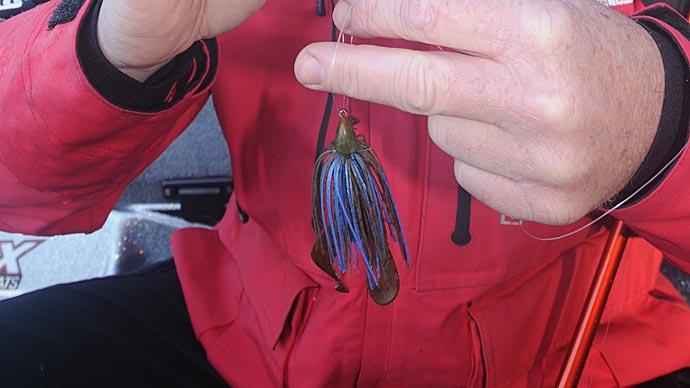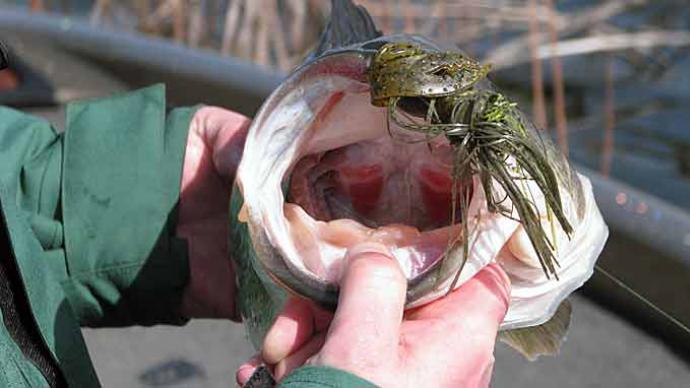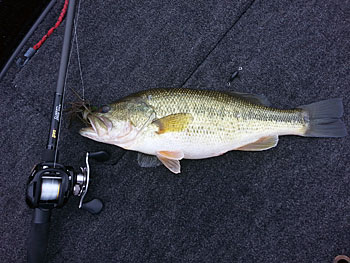
Autumn is a season of change, from warm and colorful to cold and gray. That isn’t the direction most bass anglers want to go. Yes, the exciting, fast-paced fishing that comes with warmer months may be slowing, but you can continue to find enough action to keep you warm. Like fishing during other seasons, you must find late fall and early winter bass first and then use the proper technique to catch them. And one of the best combinations for catching lots, and some big ones, are jigs on deep structure and cover. Here’s how to make it work for you.
When to go
If you follow bass through their seasonal movements, such as shallow in the spring to spawn, you’re well on your way to fishing success. As the water cools into the 40s and its level drops in late fall, bass leave the shallow flats and pockets where they chased baitfish and head to deep-water winter haunts. It’s there that they find better conditions for survival.
You’ll waste precious fishing time if you arrive before the bass on your deep-water jigging spots. Pinpointing when it’s time to fish them requires following the daily water and weather conditions. A few cold nights will not activate this pattern. Daytime temperatures need to be cold, too. It might be late December when this happens on many Southern reservoirs. In the northern parts of the country, this pattern usually comes into play in mid-October and lasts as long as open water does. Early winter or a dry summer that draws the water level down while leaves are still on the trees, for example, will push bass to their deep-water haunts sooner.
Where to fish
Bass don’t move to deep spots haphazardly. They use cover, such as weed lines or stump rows, and structure, including long tapering points and creek channels, as roads to their cold-water homes. Those are typically sharp-breaking pieces of structure with hard cover, whether rocks, brush, or a combination of both. In Southern reservoirs, a cold-water spot could be the deep end of a ditch, the tip of a point, or a creek- or river-channel ledge. It also might be on the steepest side of a hump or a bluff in a creek. In a river, it could be a deep hole that’s behind a point and protected from the current. It could be a depression on the edge of a flat or a fast-breaking rock bank in natural lakes.
To find a cold-water spot, first think about where the bass will be in a few months — spawning flats. Start there and work toward the main lake or river, following one of the before-mentioned features until you find one. They will be easy to identify on either a paper or electronic map. Once you locate both spots and how they are connected, you can stay with the bass for a good portion of the year as they move between them.
Remember, too, that deep is a relative term. Ask a Louisiana bass angler to take you to his deepest bass spot; it might be barely 10 feet. Pose the same question to a West Coast angler, and the depth could push three digits. Bass are conditioned — and limited — by their environment. So how many feet deep you’ll need to fish depends on the topography. There is no magic depth that covers multiple bodies of water.
Use the right jig and trailer.
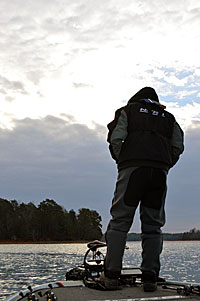
Many competitors fished deep water at the 2015 Bassmaster Classic on Lake Hartwell, the impoundment that straddles the Georgia-South Carolina line and is the headwaters of the Savannah River. Palmetto State favorite Andy Montgomery targeted ditches, standing timber, and man-made remnants of life before the reservoir, such as road culverts and bridges. He threw popular deep-water lures, such as a drop shot, but he spent the most time with his jig rod. Dropping it to the bottom, he would gently shake his jig while watching his electronics for fish activity.
Bass jigs come in a variety of shapes and weights. While you can fish all of them deep, it’s easier with certain styles. Arkie is the most popular style of bass jig. It has a flat underside and slightly rounded face, which puts most of its mass toward the front and bottom of the head. That helps it sink straight and stay pinned to the bottom. Compare it to a jig designed to snake through heavy grass. Its head is shaped like a bullet weight for plastic-worm fishing, so most of its mass sits farther back. That won’t guarantee a straight drop. Football heads are an excellent choice for deep jigging. Like the Arkie style, the weight is concentrated toward the front and bottom, and their rounded shape gives your jig a crankbait-like wobble when you drag it across the bottom.
Some jigs are explicitly marketed for deep-water fishing structure. Tournament legend Denny Brauer designed one for Strike King. While its slightly pointed nose is intended to hook a bass without forcing its mouth open, the weight, like a football jig, is positioned on the head’s belly. They are a good choice when you fish vertical, as are the football heads.
You’ll want to get the lead out, regardless of style. Jigs that weigh less than ½ ounce are tough to control in depths of 15 feet and greater, so select one that weighs at least that much. ¾- or 1-ounce jigs are better, especially if you try to jig deep for the first time. They don’t leave any doubt about being on the bottom, even when strong winter winds are rocking you.
When you select a trailer for your jig, consider how much water it moves. Ones with active kickers, such as Netbait’s Paca Chunk, work great when fishing shallow or dirty water. That’s because the wedge-shaped appendages catch water and produce lots of action. But that slows a jig’s fall. Instead, choose trailers with smaller appendages that offer less water resistance, such as a Zoom Big Salty Chunk or a craw with realistic pinchers. Neither have much drag. Pork rind is another good choice, though one that’s often forgotten. It lets your jig sink fast, and its salty flavor is a good attractor, especially in cold water.
Try a spider grub if the bite is tough, whether from fishing pressure or conditions such as clear water. They tend to be slimmer than a skirt and trailer, making it appear like an easy meal.
Choosing a color is simple. You can match the prevalent prey or follow the time-tested rule of darker colors in darker water and lighter, natural hues in clear water. Always add a touch of flash to the jig, whether that’s adding a few chartreuse or orange strands in the skirt or dying the tips of the trailer. A rattle can be beneficial in deep water. Its sound adds another level of attraction, making the jig easier for the bass to find.
Grab the right gear
Fishing deep is a chore with any lure. Choosing the right rod, reel, and line make it easier.
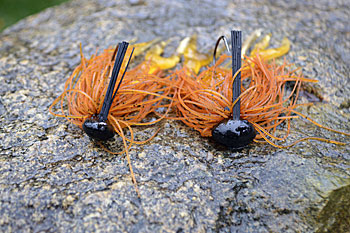
Longer rods are better for fishing in deep water. Seven-foot rods are the standard, but a 7-foot, 6-inch rod, such as a flipping stick, works well, too. They help you cast farther and, more importantly, pick up line on a hook set, overcoming any bow or stretch in the line, magnified with the extra length needed to reach the bottom. Pick a fast-action rod with medium to heavy power. That will be strong enough to drive the hooks home. Spinning or casting rods work, though the latter better handles the extra weight and bulk of jigs.
Use a reel with a gear ratio of at least 6.3:1. The faster speed brings two benefits. When fishing deep, your retrieves won’t be productive the entire way back to the boat. There will be a sweet spot when your jig is where the bass congregate. Once your jig is past it, a faster reel will burn it back to the boat, making time for more presentations. It also will help keep the line tight while fighting a bass. Many race to the surface when hooked, even in cold water.
The line is an essential element of deep-water jig fishing that is often overlooked. Fluorocarbon, in 14- to 17-pound test, is the best choice. It sinks, has little to no stretch, and is extremely sensitive. Fifty-pound test braid is a close second because it has similar characteristics. In the same tests as fluorocarbon, monofilament isn’t wrong, but be sure to choose one with the least stretch.
Set yourself up for success
Boat control is an integral part of deep-water jigging. If you are fishing a flat or the end of a point, you will cast and drag your jig across the structure and through cover. Maneuver the boat, so each cast covers the most of both. Adjust your location until you find the casting angle that generates the most bites.
When the structure is a bluff, creek- or river-channel ledge, or a sharp break on a point, and the water depth or clarity is sufficient to let you move your boat close without spooking the bass. You can pitch your jig to the sweet spots or even drop vertically.
Whichever way you go, make sure your jig sinks straight. Keep your reel open and even feed line from it by hand. If you don’t, your jig will swing toward the boat, losing some of your retrieve. That’s especially important on clear northern lakes, where late-fall bass head to steep rocky banks that drop 15 or 20 feet into a weedline. Your jig needs to be where the rocks and grass meet. If you engage your reel too soon, your jig will pendulum into the grass before it reaches the bass. You’ll know when it hits bottom because your line will go slack.
Cold water slows bass’ metabolism, and jigs don’t have enough flash to draw reaction strikes from them. So the best retrieves make your jig look natural and an easy target. Avoid the high hops that drive summertime bass crazy. Instead, use your rod tip to make your jig do small hops or slide across the bottom. Triggering strikes can be as simple as shaking the jig in place. That doesn’t take much effort, especially with a long rod, which moves more line at the tip than a shorter rod with the same amount of handle movement.


